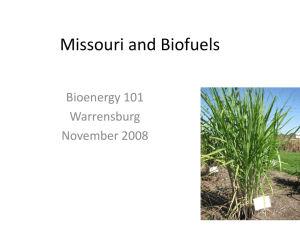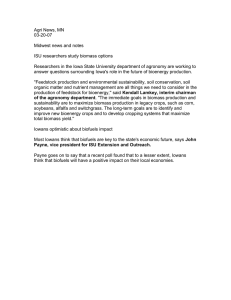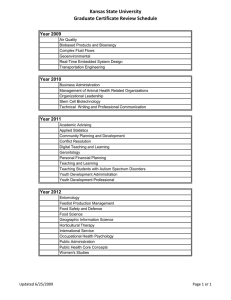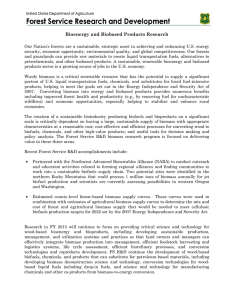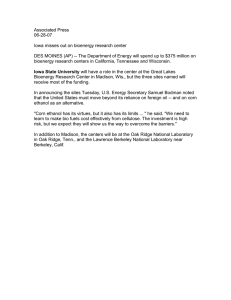Federal Funding Opportunities Bioenergy 101 Warrensburg, Missouri Don Day
advertisement
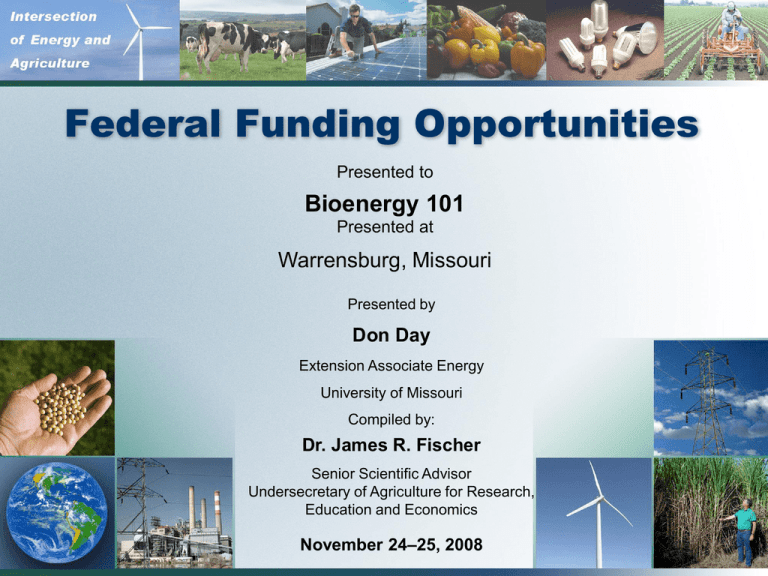
Federal Funding Opportunities Presented to Bioenergy 101 Presented at Warrensburg, Missouri Presented by Don Day Extension Associate Energy University of Missouri Compiled by: Dr. James R. Fischer Senior Scientific Advisor Undersecretary of Agriculture for Research, Education and Economics November 24–25, 2008 The Urgency In a preview of its soon-to-be-released report on global trends, the U.S. National Intelligence Council envisions a world which is reshaped by globalization, battered by climate change, and destabilized by regional upheavals over shortages of food, water, and energy (Global Trends 2025, National Intelligence Council). In a separate report, the National Intelligence Council identifies biofuels and bio-based chemicals as one of six potentially disruptive civil or dual use technologies that could emerge by 2025. The Council defines a disruptive technology as a technology with the potential to cause a noticeable degradation or enhancement in one of the elements of U.S. national power (geopolitical, military, economic, or social cohesion). U.S. and Bioenergy In the United States, funding for biofuels research has increased, and various Federal and state policies encourage deployment of biofuel technologies. There are currently over 130 ethanol refineries in operation and 77 more new plants or capacity expansions underway. There are also 105 commercial biodiesel refineries in operation. In addition, Federal and private funding is developing and deploying next generation biofuel technologies: fuels made from nonfood feedstocks such as cellulose or algae. Bioenergy – A Hot Topic in the News Producing New U.S. Energy Crops by the Barrel Brazilian companies to push for cellulosic ethanol By Don Comis, October 10, 2008 Agricultural Research Service (ARS) scientists in Peoria, Ill., have produced oils of camelina, canola, Cuphea, lesquerella, milkweed and pennycress by the barrelful in their commercialscale pilot plant. These alternative crops may be able to provide alternative domestic sources of industrial products ranging from soap to biofuels for cars, trucks and—in the case of Cuphea—even jet fuel. Plant physiologist Russ Gesch and colleagues at the ARS North Central Soil Conservation Research Laboratory in Morris, Minn., have studied Cuphea since 1999. They work closely with companies such as Procter & Gamble of Cincinnati, Ohio . .. Read more at: http://www.ars.usda.gov/is/pr/2008/ 081010.htm World Food Day stresses climate change and bioenergy effects on poor The poor will suffer most 10 October 2008, Rome – Climate change and bioenergy are the focus of this year’s World Food Day activities, expected to involve over 150 countries. FAO celebrates World Food Day each year on 16 October, the day on which the Organization was founded in 1945. “Global warming is already underway and adaptation strategies are now a matter of urgency, especially for the most vulnerable poor countries. Hundreds of millions of small-scale farmers, fishers and forest-dependent people will be worst hit by climate change . . .” Read more at: http://www.fao.org/newsroom/en/news/2008/ 1000934/index.html Big step forward for biodiesel industry Tuesday, October 14, 2008, 4:22 PM by Julie Harker The initiative includes Brazil's leading sugar and ethanol producer, Copersucar, the country's Sugar Cane Industry Association, Unica, and the local subsidiary of commodities giant Bunge (BG.N: Quote, Profile, Research, Stock Buzz) . . . Long awaited fuel specifications for biodiesel blends above B5 have been approved and the announcement came this morning from the National Biodiesel Board technical director Steve Howell who says it’s a big step forward for the biodiesel industry, “We’re very happy that after beginning the effort in 1993 we have a set of blended fuel specs that the industry can use moving forward.” Howell says the specifications are set on a performance basis for a diesel engine, not on the feedstock or the production process. He says it took the cooperation of engine, petroleum and biodiesel interests as well as government, military, research and academia to come up with these standards . . . Read more at: http://www.brownfieldnetwork.com/gestalt/go. cfm?objectid=FD3C6033-5056-B82A-D06 DAE32439CAAFC SAO PAULO, Oct 14 (Reuters) - A group of Brazilian companies and industrial organizations will set up a joint venture to finance research in cellulosic ethanol, a director at the Sao Paulo Industry Federation (Fiesp) said on Tuesday. Read more at: http://www.reuters.com/article/ rbssFinancial ServicesAndRealEstateNews/idUSN1453616 720081014 Retooled Approach May Make Bio-based Butanol More Competitive with Ethanol By Jan Suszkiw, October 16, 2008 A modified method of producing biobutanol could make the fuel more competitive with ethanol as a clean-burning alternative to gasoline. According to Agricultural Research Service (ARS) chemical engineer Nasib Qureshi, biobutanol offers several advantages. It can be transported in existing pipelines, it's less corrosive, it can be mixed with gasoline or used alone in internal combustion engines, and it packs more energy per gallon than ethanol . . . Read more at: http://www.ars.usda.gov/is/pr/2008/081016.htm 4 Unique Time in History In ways both large and small we find ourselves at a unique time in history: One in which both environmental and energy progress are integrally linked rather than oppositional. One in which clean-energy and carbon-reduction products and services offer the promise of economic development competitiveness. One in which such diverse business, investment, and political luminaries as Al Gore, T. Boone Pickens, Andy Grove, and Arnold Schwarzenegger are calling for seemingly audacious goals to meet increasingly large portions of our energy needs from clean-energy generation and efficiency measures. Willie Nelson, Richard Branson, and Vinod Khosla have been involved in biofuels research and production. 5 Scope of Today’s Presentation Policies and Funding to Promote Bioenergy Federal State Climate Action Plans USDA Bioenergy Activities Strategic Energy Science Plan BioEnergy Awareness Days Building Partnerships – REE Energy Summit on Partnerships – National Biofuels Action Plan 6 Policies and Funding to Promote Bioenergy Federal State Climate Action Plans 7 President George W. Bush – 2006 State of the Union Address Keeping America competitive requires affordable energy. And here we have a serious problem: "America is addicted to oil, which is often imported from unstable parts of the world." "The best way to break this addiction is through technology.” …. and we are on the threshold of incredible advances… “…. replace more than 75 percent of our oil imports from the Middle East by 2025.” Capitol, Tuesday, Jan. 31, 2006 White House photo by Eric Draper “By applying the talent and technology of America, this country can dramatically improve our environment, move beyond a petroleum-based economy, and make our dependence on Middle Eastern oil a thing of the past.” Advanced Energy Initiative “Change how we power our automobiles” Advanced battery technologies – plug-in hybrids Cellulosic ethanol costs Hydrogen fuel cells by 2020 “Change how we power our homes and offices” Clean Coal Nuclear Energy Renewable Energy Biofuels Initiative The Biofuels Initiative objective is to foster the production of biofuels to replace more than 75 percent of our oil imports from the Middle East by 2025 (+$53M) Achieving this ambitious goal will require looking at corn and other biomass resources to Biomass Program will initiate a produce ethanol, including: major solicitation in FY 2007 to validate near-term ethanol Benefits (2030): Develop – Agricultural crops & residues biorefineries in collaboration technologies to enable US to – Woody plants & grasses st with industry (1 validation will displace 2.6 MMbbl/d oil occur in FY 2009) equivalent, keeping $44 billion in the US economy to create jobs at home Twenty In Ten: Strengthening America's Energy Security During his 2007 State of the Union Address, President Bush announced the goal of reducing U.S. gasoline usage by 20 Percent In The Next Ten Years – “Twenty In Ten.” Goals include: – Increasing the supply of renewable and alternative fuels by setting a mandatory fuels standard to require 35 billion gallons of renewable and alternative fuels in 2017 – nearly five times the 2012 target now in law. – Reforming and modernizing Corporate Average Fuel Economy (CAFE) standards for cars and extending the current Light Truck rule. Feds Seek to Ignite Bioenergy Research In June 2007, the Department of Energy (DOE) announced it would invest $375 million over the next five years on three new Bioenergy Research Centers. The three DOE Bioenergy Research Centers— located in Oak Ridge, Tennessee; Madison, Wisconsin; and near Berkeley, California. These centers bring together multidisciplinary teams of leading scientists to advance research needed to make cellulosic ethanol and other biofuels commercially viable on a national scale, a key part of President Bush’s Advanced Energy Initiative Twenty in Ten Plan. Federal Policies & Bioenergy The Energy Independence and Security Act of 2007 (EISA, P.L. 110-140), also known as the 2007 energy bill, significantly expands existing programs to promote biofuels. The Food, Conservation, and Energy Act of 2008 (P.L. 110-246), also known as the 2008 farm bill, contains a distinct energy title (Title IX) that covers a wide range of energy and agricultural topics with extensive attention to biofuels, including corn-starch based ethanol, cellulosic ethanol, and biodiesel. Included $1 billion in mandatory funding for energy activities. 13 Key Biofuels-related Provisions of Energy and Farm Bills Reauthorization of biofuels research and development at the U.S. Department of Energy [EISA] and the U.S. Department of Agriculture and Environmental Protection Agency [farm bill]; A major expansion of the renewable fuel standard (RFS) established in the Energy Policy Act of 2005 (P.L. 109-58) [EISA]; Expansion and/or modification of tax credits for ethanol [farm bill]; Grants and loan guarantees for biofuels (especially cellulosic) research, development, deployment, and production [EISA, farm bill]; Studies of the potential for ethanol pipeline transportation, expanded biofuel use, market and environmental impacts of increased biofuel use, and the effects of biodiesel on engines [EISA, farm bill]; Expansion of biofuel feedstock availability [farm bill]; and Reduction of the blender tax credit for corn-based ethanol, a new production tax credit for cellulosic ethanol, and continuation of the import duty on ethanol [farm bill]. Source: Biofuels Provisions in the 2007 Energy Bill and the 2008 Farm Bill: A Side-by-Side Comparison, CRS Report for Congress, Updated June 27, 2008. http://www.nationalaglawcenter.org/assets/crs/RL34239.pdf 14 Key EISA and Farm Bill 2008 Biofuel Provisions: Research Topic Current or Prior Law Energy Independence and Security Act (P.L. 110-140) 2008 Farm Bill (P.L. 110-246) Biorefinery Energy Efficiency The DOE is directed to conduct research on commercial applications of biomass and bioenergy. [P.L. 109-58, Sec. 932], [42 U.S.C. 16232] Amends Sec. 932 of P.L. 109-58 to include research on energy efficiency at biorefineries and on technology to convert existing corn-based ethanol plants to process cellulosic materials. [Sec. 224] No comparable provision. Cellulosic Ethanol and Biofuels Research No prior provision. Authorizes the DOE to provide biofuels R&D grants to 10 institutions from landgrant colleges, Historically Black Colleges or Universities, tribal serving institutions, or Hispanic serving institutions. $50 million for FY2008 is authorized to be appropriated, to be available until expended. [Sec. 230] No comparable provision. Lifecycle Analysis Tools for Evaluating the Energy Consumption and Greenhouse Gas Emissions from Biofuels No prior provision. DOE is required to study and develop tools for evaluating the lifecycle energy consumption and the potential for greenhouse gas emissions from biofuels. [Sec. 232(b)] Requires USDA to support research on making a farm or ranch energy-neutral. [Sec. 7207] Small-Scale Production and Use of Biofuels No prior provision. Amends the Biofuels Research and Development Act of 2000 to require the Secretary of Agriculture to establish a R&D program to facilitate small-scale production and local and on farm use of biofuels. [Sec. 232(c)] Requires USDA support of on-farm energy conservation and renewable energy production. [Sec 7207] Bioenergy Research Centers DOE is required to establish a program of R&D and demonstration of microbial and plant systems biology, protein science, and computational biology. Biomedical research and research related to humans are not permitted as part of the program. [Energy Policy Act of 2005, P.L. 109-58, Sec. 977], [42 U.S.C. 16232] Requires the establishment of at least seven research centers that focus on bioenergy to be included in the R&D program established in Sec. 977 of P.L. 109-58. [Sec. 233] No comparable provision. 15 Key EISA and Farm Bill 2008 Biofuel Provisions: Research (cont’d) Topic Current or Prior Law Energy Independence and Security Act (P.L. 110-140) Requires DOE to establish a program of competitive grants to institutions of higher education for research on renewable energy technologies. Each grant may not exceed $2 million. A total of $25 million in discretionary appropriations is authorized for the program. [Sec. 234] 2008 Farm Bill (P.L. 110-246) University Based Research and Development Grant Program No prior provision. No comparable provision. Bioenergy Research Provides for research and development appropriations for bioenergy. [7 U.S.C. 3154] Biochar Research, Development and Demonstration No current provision. No comparable provision. Research on biochar (biomass charcoal) production and sequestration is included as a high-priority research and extension area the Research Title. [Sec. 7204] Agricultural Bioenergy Feedstock and Energy Efficiency Research and Extension Initiative The Biomass Research and Development Act of 2000 (reauthorized by the 2002 farm bill) provides competitive funding for R&D and demonstration projects on biofuels and bio-based chemicals and products, administered jointly by USDA and DOE. Specified mandatory CCC funding of $5 million in FY2002 and $14 million annually for FY2003- FY2007 to remain available until expended. Also authorized appropriations of $200 million for each of FY2006-FY2015. [P.L. 107171, Sec. 9008], [7 U.S.C. 5925] No comparable provision. Establishes the Agricultural Bioenergy Feedstock and Energy Efficiency Research and Extension Initiative in Title VII (Research) to improve biomass, production, biomass conversion in biorefineries, and biomass use. Provides grants of up to 50% of cost for energy efficient research and extension projects. Establishes a best practices database of biomass crops. Authorized appropriations of $50 million annually for FY2008-12. [Sec. 7207] Section 1419 of the National Agricultural Research, Extension, and Teaching Policy Act of 1977 (7 U.S.C. 3154) is repealed. Funding for related biomass research through USDA is contained in Title VII Sec. 7207 of the farm bill. [Sec. 7110] 16 Key EISA and Farm Bill 2008 Biofuel Provisions: Research (cont’d) Energy Independence and Security Act (P.L. 110-140) 2008 Farm Bill (P.L. 110-246) Topic Current or Prior Law Research, Extension, and Educational Programs on Biobased Energy Technologies and Products The “Sun Grant” program established 5 national sun grant research centers based at land-grant universities and each covering a different region. The purpose is to enhance coordination and collaboration between USDA, DOE, and land-grant universities in the development, distribution, and implementation of biobased energy technologies. Authorized appropriations of $25 million in FY2005, $50 million in FY2006, and $75 million annually for FY2007-FY2010. [7 U.S.C. 8109] No comparable provision. Continues sun grant program. Provides matching grants to land grant institutions to develop, distribute, and implement biobased energy technologies and to promote diversification and sustainability of agricultural production, and economic diversification in rural areas through biobased energy and product technologies. Establishes a Sun Grant Information Analysis Center. Requires annual reports. Discretionary funds of $75 million for FY2008-12 are authorized. [Sec. 7526] Biomass Research and Development Section 9008. The program — created originally under the Biomass Research and Development Act (BRDA) of 2000 — provides competitive funding for research, development, and demonstration projects on biofuels and bio-based chemicals and products, administered jointly by USDA and DOE. Specified mandatory CCC funding of $5 million in FY2002 and $14 million for each of FY2003 through FY2007 (available until expended). Additional appropriation authority of $200 million for each of FY2006 through FY2015. [7 U.S.C. 8101] No comparable provision. New section 9008. Defines biobased product. Provides for coordination of biomass research and development between USDA and DOE. Establishes the Biomass Research and Development Board and the Biomass Research and Development technical Advisory Committee to assist the Board in coordinating biomass research in the Federal government. USDA and DOE are to establish a Biomass Research and Development Initiative to competitively award grants, contracts, and financial assistance for research on biofuels and biobased products production, and biobased feedstocks and development. Grants are to be awarded to universities, national laboratories, state and federal research agencies, private businesses, and nonprofits. Mandatory funding is authorized of $20 million for FY2009, $28 million for FY2010, $30 million for FY2011, and $40 million for FY2012. Discretionary funding of $35 million annually is authorized to be appropriated for FY2009-12. [Sec. 9001] 17 Key EISA and Farm Bill 2008 Biofuel Provisions: Research (cont’d) Topic Forest Biomass for Energy Program Current or Prior Law No current provision. Energy Independence and Security Act (P.L. 110-140) No comparable provision. 2008 Farm Bill (P.L. 110-246) New section 9012. Requires the Forest Service to conduct a competitive research and development program to encourage use of forest biomass for energy. Priority given to projects that utilize low-value forest byproducts, integrate the production of energy from forest biomass with existing manufacturing streams, develop new transportation fuels from forest biomass, or improve the production of forest biomass feedstocks. Appropriations of $15 million per year are authorized for FY2009-12. [Sec. 9001] 18 Key EISA and Farm Bill 2008 Biofuel Provisions: Education Topic Current or Prior Law Energy Independence and Security Act (P.L. 110-140) 2008 Farm Bill (P.L. 110-246) Consumer Information No prior provision. The Dept. of Transportation is required to carry out an educational program to inform consumers about the fuel savings and emissions benefits of new vehicles, including the benefits from the use of alternative fuels. [Sec. 105] No comparable provision. Federal Procurement of Biobased Products Under the 2002 farm bill, federal agencies are required to purchase biobased products under certain conditions. Current law authorizes a voluntary biobased labeling program. USDA regulations define biobased products, identify biobased product categories, and specify the criteria (including testing) for qualifying those products for preferred procurement. Mandatory Commodity Credit Corporation (CCC) funding of $1 million was authorized for each of FY2002FY2007 for testing biobased products. [P.L. 107171, Sec. 9002], [7 U.S.C. 8102] No comparable provision. New section 9002. Renames as the Biobased Markets Program. Extends the program through FY2012 and refines federal procurement rules for biobased products. Requires federal agencies to maximize procurement of biobased products and submit reports to Congress. Continues voluntary labeling. Establishes testing centers and education grants. Authorizes mandatory funding of $1 million for FY2008 and $2 million annually for FY2009-12. Discretionary funding of $2 million in annual appropriations is authorized for FY200812. [Sec. 9001] Biodiesel Fuel Education Program Awards competitive grants to nonprofit organizations that educate governmental and private entities operating vehicle fleets, and educate the public about the benefits of biodiesel fuel use. Mandatory CCC funding of $1 million annually was authorized for FY2003- FY2007. [P.L. 107-171, Sec. 9004], [7 U.S.C. 8104] No comparable provision. New section 9006. Extends the Biodiesel Fuel Education Program through FY2012. Provides mandatory CCC funding of $1 million annually for FY2008-12. [Sec. 9001] 19 Key EISA and Farm Bill 2008 Biofuel Provisions: Education (cont’d) Topic Current or Prior Law Energy Independence and Security Act (P.L. 110-140) 2008 Farm Bill (P.L. 110-246) Renewable Energy Systems and Energy Efficiency Improvements Authorizes loans, loan guarantees, and grants to farmers, ranchers, and rural small businesses to purchase and install renewable energy systems and to make energy efficiency improvements. Mandatory CCC funding of $23 million annually for FY2003-FY2007. [P.L. 107-171, Sec. 9006], [7 U.S.C. 8106] No comparable provision. New section 9007. Renamed as the “Rural Energy for America Program,” Funds energy audits for state agencies, cooperatives, educational institutions and utilities. Provides grants, loan guarantees and incentive payments for energy efficiency and renewable energy, and manure-toenergy projects. Reserves 20% for small projects. Mandatory funds of $55 million for FY2009, $60 million for FY2010, $70 million for FY2011, and $70 million for FY2012. Discretionary appropriations of $25 million annually for FY200912 are authorized. [Sec. 9001] University Based Research and Development Grant Program No prior provision. Requires DOE to establish a program of competitive grants to institutions of higher education for research on renewable energy technologies. Each grant may not exceed $2 million. A total of $25 million in discretionary appropriations is authorized for the program. [Sec. 234] No comparable provision. Research, Extension, and Educational Programs on Biobased Energy Technologies and Products The “Sun Grant” program established 5 national sun grant research centers based at land-grant universities and each covering a different region. The purpose is to enhance coordination and collaboration between USDA, DOE, and land-grant universities in the development, distribution, and implementation of biobased energy technologies. Authorized appropriations of $25 million in FY2005, $50 million in FY2006, and $75 million annually for FY2007-FY2010. [7 U.S.C. 8109] No comparable provision. Continues sun grant program. Provides matching grants to land grant institutions to develop, distribute, and implement biobased energy technologies and to promote diversification and sustainability of agricultural production, and economic diversification in rural areas through biobased energy and product technologies. Establishes a Sun Grant Information Analysis Center. Requires annual reports. Discretionary funds of $75 million for FY2008-12 are authorized. [Sec. 7526] 20 Energy and the Obama Administration The energy future looks bright with the Obama administration. He has consistently voted for renewables and even used the word “biofuels” in his speeches. Highlights of his proposed energy plan include… Help create five million new jobs by strategically investing $150 billion over the next ten years to catalyze private efforts to build a clean energy future. Put 1 million Plug-In Hybrid cars – cars that can get up to 150 miles per gallon – on the road by 2015, cars that we will work to make sure are built here in America. Ensure 10 percent of our electricity comes from renewable sources by 2012, and 25 percent by 2025. Implement an economy-wide cap-and-trade program to reduce greenhouse gas emissions 80 percent by 2050. States with Mandates and Incentives Promoting Biofuels Renewable Fuels Standards with Biofuel Mandates Excise Tax Exemptions, Tax Credits, and/or Grants Promoting Biofuel Production and Use Source: http://www.pewclimate.org/what_s_being_done/in_the_states/map_ethanol.cfm July 2007. 22 Missouri Voters Approve a Renewable Energy Requirement Missouri voters approved a measure requiring state's investor-owned utilities to use renewable energy for 15% of their electricity supply by 2021. The renewable requirement starts at 2% of sales in 2011 and gradually ratchets up to the 15% requirement by 2021. The Missouri Clean Energy Initiative, or Proposition C, passed easily, garnering approval from 66% of the state's voters and passing in every county but one. The ballot measure also allows utilities to buy their renewable power from out of state and to meet up to 100% of the requirement through the purchase of renewable energy credits (RECs), which can be bought from renewable energy facilities throughout the country. According to the Database of State Incentives for Renewable Energy (DSIRE), 28 states and the District of Columbia now have a mandatory requirement for renewable energy use. State Governments Taking Steps to Mitigate Carbon Emissions ND In February 2007, this region ME WA agreedpassed to set alegislation cap for WI California SD VT MI requiring 25% cut in carbon carbon emissions before theNH OR IA NY emissions by 2020 totoreduce end of 2007 and establish NE MA Regional Greenhouse Gas OH IN IL emissions to 1990 levelssystem CT RI an emission trading Initiative has target of KS MO PA by August 2008 NJ stopping emissions increase Nine Midwestern governors CA by 2009; reducing them by and two Canadian MD DE premiers have signed on to participate 10% from 2005 levels by 2019 AZ NM or observe in the Midwestern Greenhouse Gas Reduction Accord (Accord) as first agreed to November 2007. MN Other states and cities have also taken action 24 Biofuels Part of Low-Carbon Fuel Standard Strategy in California Global Warming Solutions Act passed by California Legislature (2006) – adopted regulations to control GHG emissions, starting no later than 2012. Subsequent Executive Order (S-1-07) for the Low Carbon Fuel Standard (LCFS) in January 2007, set a statewide goal to reduce the carbon intensity of California’s transportation fuels at least 10 percent by 2020. Recent report* states: “We find it possible to either manufacture a significant amount of low-carbon fuel within California or to import it from outside the state. Many of the low carbon fuels expected to be commercially available in large quantities within the 2020 time horizon are biofuels.” * A Low-Carbon Fuel Standard for California, Part 1: Technical Analysis August 1, 2007, Project Directors, Alexander E. Farrell, UC Berkeley www.its.berkeley.edu/sustainabilitycenter and Daniel Sperling, UC Davis www.its.ucdavis.edu; http://www.energy.ca.gov/low_carbon_fuel_standard/UC-1000-2007-002-PT1.PDF 25 USDA Bioenergy Activities: Strategic Energy Science Plan BioEnergy Awareness Days Building Partnerships –REE Energy Summit on Partnerships –National Biofuels Action Plan 26 REE Energy Plan Energy is a national and international problem. USDA/REE and the land grants have a major role in the solution of this problem through research, education, and extension. REE/USDA has developed a strategic energy plan to address these issues. Goals of the plan include: – Sustainable agriculture- and natural resource-based energy production; – Sustainable bioeconomies for rural communities; – Efficient use of energy and energy conservation; and – Workforce development for the bioeconomy 27 Goal Action Teams to Implement USDA Energy Plan 35 teams comprised of individuals from USDA and other organizations are working to implement the 4 Plan goals. Various team objectives are listed below. Goal 1. Sustainable Agriculture and Natural ResourceBased Energy Production – Identify research needs related to feedstock genetic and genomic resources – Conduct economic analysis of sustainable feedstock production and logistics – Evaluate bioproducts that could replace products currently made from petroleum Goal 2. Sustainable Bioeconomies for Rural Communities – Inventory research assessing the implications of bioenergy for agricultural producers and rural communities – Inventory existing community and farmer decision tools related to energy, e.g. tillage energy estimator and others 28 Goal Action Teams (continued) Goal 3. Efficient Use of Energy and Energy Conservation – Establish a National Energy Extension and eXtension community of practice for home energy with DOE and LGU participation – Develop a MOU for cooperation between National Rural Electric Cooperative Association (NRECA) and USDA/REE for cooperation in addressing energy efficiency in rural areas – Establish metrics for measuring energy intensity of agricultural production Goal 4. Workforce Development for the Bioeconomy – Complete education roadmap – Finalize funding strategy to increase investment in education – Develop and implement series of education programs 29 Science and Education Is The Power to Move us Down the Road of the Future Renewables – Geothermal, Solar, Hydrogen, Biomass, Wind Technology Disciplines such as Science and Engineering Social Disciplines such as Economics, Marketing, and Psychology Energy Efficiency – Buildings, Vehicles, Industrial & Distributed Energy 30 Biotechnology Education Programs Increasing K-8: South Carolina Ag in the Classroom ) (SC Farm Bureau) High Schools: – A November New York Times article discusses high schools in San Francisco have one of the most sophisticated biotech programs in the country, perhaps because of the city’s proximity to thriving biotech companies. Universities: – Kansas State University's Center for Sustainable Energy (consolidating university-wide work on bioenergy) – Biorenewable Resources and Technology (BRT) at Iowa State University Workforce Development: Michigan State University & Lansing Community College providing biorefinery operations training for approximately 600 workers and students in its first two years of operation 31 MU Center for Sustainable Energy CAFNR College of Engineering Involves – Research – Teaching – Extensioin 32 The Department of Biological and Agricultural Engineering (BAEN) and the Department of Soil and Crop Sciences (SCSC) at Texas A&M University invite applications for 3 minority USDA National Needs Fellowships at the Doctorate level. These fellowships are available immediately for students in engineering and soil and crop sciences for bioenergy research. Research Areas: The selected candidates will pursue a Doctor of Philosophy degree in either the BAEN Dept. (engineering students) or the SCSC Dept. to develop sustainable bioenergy systems. For more information please see our website at: http://baen.tamu.edu/academics/nnf/bioenergy 33 BioEnergy Awareness Days (BEAD) – An Integral Part of Energy Plan Bio Energy Awareness Days (BEAD) is an annual celebration held on the Summer Solstice to acknowledge the ultimate source of energy is the sun. The purpose of this second annual event (BEAD II) is to help increase awareness and knowledge related to the sustainable production of agriculture, forest, and natural resource-based renewable energy and bioproducts; sustainable bioeconomies; the efficient use and conservation of energy for the benefit of rural communities and the Nation; and related workforce development. 34 The Second Annual BioEnergy Awareness Days (BEAD II) BEAD II was held from June 19-22, 2008 during the Summer Solstice. Organized by USDA/REE and co-sponsored by the 25X'25 Alliance. The event included: – The Grand Challenge competition for colleges of agriculture at land grants and other institutions of higher education (13 winners) – Exhibits of technologies that universities are developing for the new energy economy involving agriculture (31 universities) – "Power Plant Garden" at the U.S. National Arboretum 35 36 POWER Plants U. S. National Arboretum Corn Switchgrass Barley Hybrid popular Sorghum Miscanthus Sugar beet Alfalfa Sunflower Mustard Soybean Canola Sugar cane Jatropha Camelina Castor bean Peanut Lesquerella Cuphea Babassou Palm African Oil Palm Algae 37 Bradford Farm BioFuel Garden Crops Include Peanuts Sweet sorghum Easter Gammagrass Forage sorghum Miscanthus Canola Sunflowers Indiangrass Big Bluestem Sugarcane Sugar beets Soybean Corn Switchgrass 39 USDA/REE Energy Summit Energy is a complex topic and it will take considerable effort to make changes: “Complex things are a gathering of many simple things.” “There is no magic. Spectacular success results from unspectacular preparation.” 40 USDA/REE Energy Summit (cont’d) Requirements for building effective partnerships include: Close the “Value Gap” which is the high-cost disconnect between value promised and value achieved. Develop more “interactive” than “reactive” relationships. Mitigate the three challenges of collaboration: – Change – Cast of Characters – Culture 41 USDA/REE Energy Summit (cont’d) Focus on the psychology of change is characteristic of successful partnerships. Attributes of successful collaborations include: A joint work product; Commitment to a common purpose; Shifting leadership rather than a requirement to report to one individual; Non autocratic teams that contain the emotional and spiritual energy that is needed for collaboration; Availability of many “soft” skills such as emotional intelligence including personal competence (self awareness and self-management and social competence – social awareness and relationship management). 42 Take-Home Message from the USDA/REE Energy Summit 1.Partnerships are necessary. 2.Partnerships require new and innovative tools. 3.Partnerships require innovative management. 4.Partnerships require having the right people at the table. 43 BUILDING PARTNERSHIPS BIOECONOMY FUTURE 44 Joint DOE/USDA National Biofuels Action Plan DOE and USDA released on October 7 the National Biofuels Action Plan (NBAP) This is an interagency plan that details the collaborative efforts of federal agencies to accelerate the development of a sustainable fuel industry. The NBAP outlines interagency actions in 7 areas: – Sustainability – Feedstock production – Feedstock logistics – Conversion science and technology – Distribution infrastructure – Blending – Environment, health and safety http://www1.eere.energy.gov/biomass/pdfs/nbap.pdf 45 Some suggestions: 46 Together – We Can Build a Prosperous Bioeconomy Future Where we will: Transition to a carbohydrate-based economy Produce our products and fuels in biorefineries Improve national security and the U.S. trade balance Realize important environmental benefits Develop significant, new sustainable economic opportunities for rural America Lead exploiting these technologies to other countries. 47
